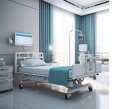 Let me set the scene—you’re recovering in a hospital room. Any bacteria or airborne illness could lengthen your stay, put you at risk, but you’re ready to head on home—NOW! But instead of worrying about the cleanliness of your room or how fresh the air you’re breathing is—you’re just focused on your recovery. That’s exactly how it should be with high-tech HVAC systems!
Let me set the scene—you’re recovering in a hospital room. Any bacteria or airborne illness could lengthen your stay, put you at risk, but you’re ready to head on home—NOW! But instead of worrying about the cleanliness of your room or how fresh the air you’re breathing is—you’re just focused on your recovery. That’s exactly how it should be with high-tech HVAC systems!
Here’s the inside scoop on why high-tech HVAC and building automation systems are becoming a game-changer in healthcare facilities so that patients and staff can breathe easier and safer.
Breathing easy with improved air quality
Remember that episode of Grey’s Anatomy where everyone was freaking out about airborne germs? (No? Just me?)
High tech HVAC systems work with building automation systems to optimize air circulation and filtration. They work quietly (or not so quietly) behind the scenes silently filtering out dust, allergens, and pathogens that could make you sicker.
Saving green while going green
Let’s face it, hospitals use a LOT of energy. Thankfully, new high-tech HVAC and building automation technologies are like a superhero duo fighting against energy waste. Smart controls and demand-based ventilation ensure these systems only work as hard as they need to, keeping hospitals comfortable and budgets happy. Plus, with a focus on sustainability becoming a top priority, these systems are helping healthcare facilities reduce their environmental footprint.
The Internet of Things (IoT) steps up its game
Imagine a system that can monitor itself, predict when it needs maintenance, and even adjust settings based on real-time data. That’s the power of integrating high-tech HVAC and building automation with the Internet of Things (IoT) and big data. This futuristic tech allows for real-time monitoring, predictive maintenance, and data-driven optimization of building systems. Basically, the system becomes like a self-aware robot, constantly working behind the scenes to ensure optimal performance and minimize problems.
Keeping everyone comfortable (and focused)
Hospitals aren’t just for patients – they’re workplaces too! Modern high-tech HVAC systems, with precise temperature and humidity control, coupled with building automation systems that manage air distribution evenly, create a comfortable environment for both patients and staff. This might not seem like a big deal, but studies show that a comfortable environment can lead to faster recovery times for patients and better focus for medical professionals – a win-win for everyone!
Adapting to the changing world of healthcare
With telehealth on the rise, hospitals need to adapt their energy use. Enter occupancy-based controls and remote monitoring capabilities! These features allow HVAC and building automation systems to adjust based on how many people are actually in a room, preventing wasted energy when areas are underutilized.
The future of high-tech healthcare is (climate) controlled
The future of healthcare facilities is all about creating healthy environments, optimizing operations, minimizing environmental impact, and taking care of patients. Advanced HVAC and building automation systems are at the forefront of this movement. By investing in these high-tech heroes, hospitals can create a healthier world for everyone, one comfortable breath at a time.
Explore some Kele product categories that can contribute to these goals within a healthcare setting:
Energy-efficient high-tech HVAC products:
-
- Variable Speed Drives (VSDs): These optimize motor performance in HVAC systems, reducing energy consumption.
- Energy Recovery Ventilators (ERVs): These capture heat or coolth from outgoing air and transfer it to incoming fresh air, minimizing energy needed to reach desired temperatures.
- High-Efficiency Chillers: These advanced chillers use less energy to provide cooling for buildings.
Indoor Air Quality (IAQ) solutions:
-
- UV Air Disinfection Systems: These utilize ultraviolet light to inactivate airborne pathogens, contributing to a healthier environment.
Smart controls and building automation:
-
- Building Management Systems (BMS): These centralized systems integrate with HVAC equipment and provide real-time data on energy usage and system performance. This allows for data-driven optimization to minimize energy waste.
- Smart Thermostats and Occupancy Sensors: These can adjust heating and cooling based on real-time occupancy or temperature readings, preventing unnecessary energy consumption in unoccupied areas.
These product categories can contribute to a more sustainable and energy-efficient, high-tech healthcare environment. Call or source online today—Kele’s got your next healthcare facility job covered.
